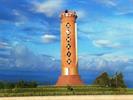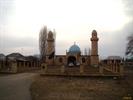The ancient fortified town of Old Shamkir lies ruined, silent and forgotten on the northern outskirts of the little village of Muxtariat. The remnants are limited to some massive but stubby chunks of bastion - brick interlaced with rock sections -which are still several metres high in places.
Old Shamkir was the site of a major battle with Georgia in 1195 and the whole city was flattened by Charmaghan and the Mongol horde in 1235. Though later rebuilt, along with a bridge across the Shamkirchay river (the supporting pillars still stand), it never regained its strategic importance.
Confusingly, today's Shamkir is 20km away. That town started life as the German settlement of Annanfeld which, like Xanlar and Ganja, was partially depopulated when ethnic Germans were banished by Stalin in 1941. In January 1918 nearly 1000 people, died near the station in an infamous confrontation between red-Russian troops and Azeri nationalists who were trying to requisition their guns. This further aggravated relations with the Bolsheviks contributing perhaps to the March Days massacres later that year.
Today Shamkir retains a disuset square-towered church (built in 1909) with paint peeling from its wooden ceiling. The neat, tree-lined avenues have changed names so often that the town has given up on street signs.
History
Since the V century the city is known as Shamkur - the great trade and handicraft centre of Persia. In 652, the city was seized by the Arabian troops. In 737, Khazars were resettled to Shamkir after the Arabian commander Mervan's campaign to the Volga. In 752, the city was destroyed by the Sabir people, who lived not far from the city and deprecated the Arabs. In 854, the Muslim Khazars took refuge in re-established Shamkir. Later, the city was under the reign of Ganja amirs from the Kurdish dynasty of Shaddadids. In XII century-in the beginning of the XIII centuries Shamkir was under the Georgian reign. In 1195, the Georgian Queen Tamar's commanders destroyed the troops of Azerbaijan's Atabey Abu-Bakr, who was from Seljuk dynasty of the Ildegizids. In 1235, Shamkir was destroyed by Mongolian noyon Molar. From the first quarter of the XVI century till the beginning of the XIX century Shamkir was governed by hereditary rulers of Azerbaijani (Qizilbash) tribe called Shamsaddinli-Zulgadar. In 1803, during the military actions against Ganja khanate, Shamkir was taken up by Russian troops and annexed to Russia. On September 3, 1826, during the Russo-Iran war Shakh's guard consisting of 10000 soldiers was destroyed under Shamkir. In 1818, a German colony, resettled from Wurttemberg to Annenfeld appeared in the territory of Shamkir. From 1914 the city was called Annino, but from 1938-Shamkhor. In 1944, Shamkhor was given the city status. In 1991, the historical name of the city was restored.
If you're planning a trip to Azerbaijan you may be interested ▶ Azerbaijan highlights - For those who prefer to go unbeaten path, to explore less visited places and check national charisma of this small country in Southern Caucasus on the edge of Europe.








